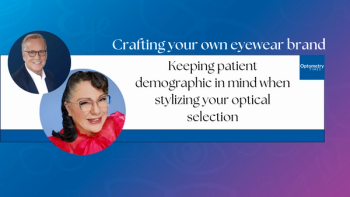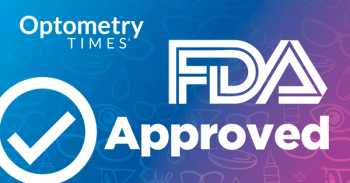
Ocular manifestations of systemic hypertension
Systemic hypertension has reached epidemic proportions in the United States, and aggressive and creative treatment approaches are needed. Optometrists are already well positioned to provide valuable primary care services for hypertensive patients, regardless of whether or not they are ever involved in directly treating the disease.
Figure 1. Combined hypertensive and diabetic retinopathy.
Figure 2. Hypertensive retinopathy (Bonnet Sign, silver wiring) plus diabetic retinopathy
A California legislator recently introduced Senate Bill 492, which would allow optometrists to treat chronic systemic problems, such as hypertension. Guaranteed to stir discussion and add fuel to ongoing scope-of-practice turf wars, SB 492 is indicative of the growing concern over the increased numbers of primary-care practitioners needed to treat both current patients and new ones who will be entering the health care system under the Affordable Care Act.
In light of this projected shortfall of doctors, it’s good to recall what optometrists already do well-directly viewing retinal vasculature and tissues and diagnosing the ophthalmic end-organ damage caused by systemic hypertension. This privileged view enables optometrists to play a valuable role in limiting both ocular and systemic damage from hypertension.
Clinical findings
The majority of ophthalmic manifestations of systemic hypertension center around damage caused by abnormal vascular autoregulation.1 Increased perfusion pressure results in arteriolar constriction to regulate retinal blood flow. Chronic vasospasm leads to both diffuse and focal arteriolar narrowing and increased vascular tortuosity. Hardening of the arterioles (arteriosclerosis) can manifest as the classic Gunn or Bonnet signs (arteriovenous, or AV nicking), which are characterized by compression of an underlying venule by an overlying arteriole.2 As an arteriole continues to harden, it can deflect a venule enough to change its course (Salus’ sign) and eventually set the stage for a branch vein occlusion (BRVO).
Increased arteriolar blood pressure also damages arteriole endothelium, leading to thickening of the vessel wall and narrowing of the lumen. This is seen as change in the arteriolar light reflex (ALR) formed by the interface of the blood column and the vessel wall, first as a diffuse, less bright ALR, then as an increase in the width of the ALR (copper wiring). In more advanced cases, the ALR widens to encompass the entire width of the arteriole (sheathing or silver wiring).3
Figure 3. Gunn sign, increased ALR, tortuosity.
Figure 4. Bonnet sign, increased ALR, arteriolar narrowing.
Proportional effects
Chronic hypertensive retinopathy worsens in proportion to the length of time that systemic blood pressure remains above normal. Acute, or malignant, hypertensive retinopathy, however, is proportional to the amount above normal of the presenting blood pressure reading.2 It can quickly cause a breakdown in the blood-retinal barrier, manifesting as dot and blot hemorrhages in the inner retina, flame hemorrhages in the nerve fiber layer (NFL), cotton wool spots (CWS) from NFL ischemia and axonal swelling, and macroaneurysms. Exudates can form, including the classic macular star. Severe acute hypertensive retinopathy can lead to complications, such as hemorrhagic detachment of the internal limiting membrane, as well as subhyaloid and vitreous hemorrhage.3
Chronic hypertensive choroidopathy
While often overlooked, hypertension also produces changes in the choroid and optic nerve. Chronic hypertensive choroidopathy manifests as a diffuse pigment granularity, RPE clumping surrounded by atrophic areas (Elschnig spots), and triangular patches of atrophy. Acute hypertensive choroidopathy can produce linear RPE changes, or Seigrist’s streaks, as well as focal pigment epithelial detachments, serous retinal detachments, and cystoid macular edema.4
Optic nerve swelling from acute exudative changes can be present in cases of malignant hypertension. Swelling usually resolves with good systemic treatment, but nerve pallor and optic nerve dysfunction may remain. Chronic systemic hypertension can also lead to gradual compromise of the peripapillary choroidal vessels and posterior ciliary arteries that serve the optic nerve, resulting in slow-onset nerve pallor, or in cases of acute obstruction, classic non-arteritic ischemic optic neuropathy (NAION).2
Finally, other ophthalmic manifestations of systemic hypertension can be visualized externally. Palsies of cranial nerves III, IV, VI, and VII can all occur secondary to chronic or acute systemic hypertension. Subconjunctival hemorrhages, while usually secondary to a Valsalva maneuver, can also occur in conjunction with acute blood pressure elevation.
Classification
Liebreich first described hypertensive retinopathy in 1859. Since then, many researchers have proposed numerous classification schemes, most notably, the Keith-Wagener Barker (KWB,), the Scheie, and the Modified Scheie systems (see Table 1).5-7
However; current thought challenges the relevance of previous classification systems. Poor correlation of retinal signs with severity of hypertension; the presence of retinal signs in normotensives; a lack of predictable progression in clinical signs; the recognition of choroidopathy and optic neuropathy as separate manifestations; and poor inter-observer reliability have all led to the current trend of simply describing what you see. This approach, while noting nonmalignant (chronic) vs. malignant (acute) forms of the disease, as well as severity (mild, moderate, severe), provides a useful framework for determining the urgency of treatment and referral.8
Treatment and management
Fundamentally, treating hypertensive retinopathy and other ophthalmic manifestations of hypertension is focused on lowering blood pressure to safe levels.
For previously undiagnosed hypertensives, diagnosis of early hypertensive retinopathy can result in prompt initiation of treatment. For previously diagnosed hypertensives, the presence of more advanced retinopathy or changes in retinopathy from a previous exam might lead to changes in or additions to antihypertensive medications.
Figures 5 and 6 (above and below). Malignant hypertensive retinopathy. (Photos courtesy of Michael D. Brown, OD)
In general, the urgency of antihypertensive treatment increases with the severity of ophthalmic signs. Malignant hypertensive retinopathy indicates a serious breakdown in the eye’s autoregulation and a hypertensive crisis that calls for immediate referral and treatment. However, blood pressure should be lowered gradually over the course of hours because rapid reduction could lead to optic nerve or systemic hypoperfusion and subsequent infarct. 9 Blood pressure should always be checked in the presence of bilateral disc edema, regardless of whether or not retinal hemorrhages are present, because malignant hypertension can sometimes present with minimal microvascular change.10
Practitioners also should be alert to asymmetry in hypertensive retinopathy because this could be a sign of carotid artery disease. It is sometimes difficult to distinguish between hypertensive and diabetic retinopathies in cases of concomitant disease, but it is important to remember that uncontrolled hypertension can worsen diabetic retinopathy, and better blood pressure control can decrease the risk of diabetic macular edema and proliferative changes.
Associated eye conditions, such as vascular occlusions or NAION, should be managed either through observation or specialty consultation, depending on severity. In addition, optometrists need to consider differential diagnoses, such as autoimmune disease, anemia, radiation retinopathy, central retinal vein occlusion (CRVO), ocular ischemic syndrome, leukemia, and blood dyscrasias in the presence of apparent hypertensive retinopathy.4
We’ve seen that systemic hypertension has reached epidemic proportions in the United States, and aggressive and creative treatment approaches are needed. Optometrists are already well positioned to provide valuable primary-care services for hypertensive patients, regardless of whether or not they are ever involved in directly treating the disease.ODT
References
Tso M, Abrams G, and Jampol L. Hypertensive retinopathy, choroidopathy, and optic neuropathy. In: Singerman L, Jampol L, eds. Retinal and Choroidal Manifestations of Systemic Disease. Baltimore: Williams & Wilkins, 1991, 79-127.
Chatterjee S, Chattopadhya S, Hope-Ross M, et. al. Hypertension and the eye: changing perspectives. J Hum Hypertens 2002;16:667-675.
Oh KT, Moinfar N, et. al. Ophthalmic manifestations of hypertension. Medscape Reference: Drugs, Diseases & Procedures. http://emedicine.medscape.com/article/1201779-overview#showall. Accessed April 21, 2013.
Kim, JE. Hypertensive retinopathy. EyeWiki. http://eyewiki.aao.org/Hypertensive_retinopathy. Accessed April 21, 2013.
Keith N, Wagener H, Barker N. Some different types of essential hypertension: their course and prognosis. Am J Med Sci 1939;197:332-343.
Scheie H. Evaluation of ophthalmoscopic changes of hypertension and arteriolar sclerosis. Arch Ophthalmol 1953;49(2):117-138.
Dodson P, Lip G, Eames S, et.al. Hypertensive retinopathy: a review of existing classification systems and a suggestion for a simplified grading system. J Hum Hypertens 1996;10:93-98.
Hyman B. The eye as a target organ: An updated classification of hypertensive retinopathy J Clin Hypertens 2000;2:194-197.
Isles C. Hypertensive emergencies. In: Swales J, ed. Text Book of Hypertension. Oxford: Blackwell Scientific Publications, 1994, 1233.
Lip G, Beevers M, Dodson P, et.al. Severe hypertension with lone bilateral papilloedema: a variant of malignant hypertension. Blood Press 1995;4:338-342.
Dr. BrownAuthor Info
Dr. Brown has practiced medical optometry with the U.S. Department of Veterans Affairs Outpatient Clinic in Huntsville, AL, for over 20 years. He has served as an adjunct professor with both the University of Alabama at Birmingham School of Optometry and the University of Alabama School of Medicine. He has a special interest in complex corneal and anterior segment cases. Dr. Brown did not indicate a financial interest in the topic. E-mail him at idoc61@gmail.com.
Take-Home Message
Systemic hypertension has reached epidemic proportions in the United States, and aggressive and creative treatment approaches are needed. Optometrists are already well positioned to provide valuable primary care services for hypertensive patients, regardless of whether or not they are ever involved in directly treating the disease.
Uncontrolled hypertension can worsen diabetic retinopathy, and better blood pressure control can decrease the risk of diabetic macular edema and proliferative changes.
Newsletter
Want more insights like this? Subscribe to Optometry Times and get clinical pearls and practice tips delivered straight to your inbox.



















































.png)


